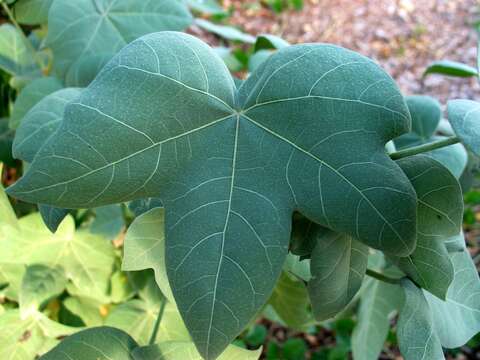Gossypium tomentosum

Description:
Mao or Hawaiian cottonMalvaceae (Mallow family)Endemic to the Hawaiian Islands (All the main islands except Hawaii Island)Status: Vulnerable; uncommon to rareOahu (Cultivated)Closeup of shrubwww.flickr.com/photos/dweickhoff/5187431929/in/photostream/Habitwww.flickr.com/photos/dweickhoff/5188031962/in/photostream/The name mao comes from the Hawaiian word mao for green and shares the same name as the native Hawaiian thrush, mao (Myadestes obscurus) which has a greenish cast to its feathers.The early Hawaiians used the leaves for a light green (maomao) or a rich red-brown dye. Isabella Abbott notes that "any green kapa deserves close scrutiny, too, for the green obtained from mao leaves is fleeting, fading within a few days. The Bishop Museum collection contains no kapa that has retained its green coloration, but a few pieces may once have been green, judging by their overall design." The flower petals also produced a yellow dye.Mao flowers were used in lei making.Apparently, the fibers were also used for medicinal applications much as a cotton swab would be used today. For severe stomach cramps, the dried flowers were eaten along with other plants while also drinking a tea made with mao bark and other plants. The flowers and bark of tap roots mixed with other ingredients were used to treat gripping stomach aches, such as during childbirth.The flowers were sun dried and eaten. Other plant parts were made into a liquid for consumption.Although the fibers were once used by early Hawaiians for stuffing pillows, it was not used as a fabric.Modern UseThe native Hawaiian cotton, or mao, helped to save the cotton industry in modern times. When mao is crossed with other cotton strains, the resulting commercial hybrids are less attractive to insect pests that destroy cotton crops.A commercial cotton industry was started in Kailua, Hawaii Island in 1838 and lasted for about a century, but never became an important trade.There is still so much to learn about our flora and the example of mao underscores the value of saving our native plants.EtymologyThe generic name Gossypium is derived from the Greek name for cotton, gossypion.The specific epithet tomentosum from the Latin tomentosus or tomentose, meaning "covered with tangled or matted, woolly hairs."NPH00007nativeplants.hawaii.edu/plant/view/Gossypium_tomentosum
Included On The Following Pages:
- Life (creatures)
- Cellular (cellular organisms)
- Eukaryota (eukaryotes)
- Archaeplastida (plants)
- Chloroplastida (green plants)
- Streptophyta
- Embryophytes
- Tracheophyta (ferns)
- Spermatophytes (seed plants)
- Angiosperms (Dicotyledons)
- Eudicots
- Superrosids
- Rosids
- Malvales
- Malvaceae (mallows)
- Gossypium (cotton)
- Gossypium tomentosum (Hawai'ian cotton)
This image is not featured in any collections.
Source Information
- license
- cc-by
- copyright
- David Eickhoff
- photographer
- David Eickhoff
- original
- original media file
- visit source
- partner site
- Flickr Group
- ID


